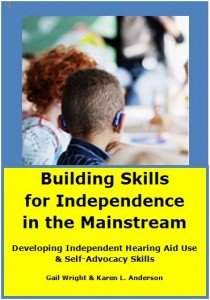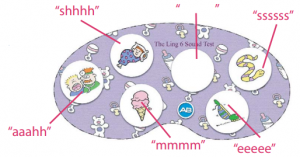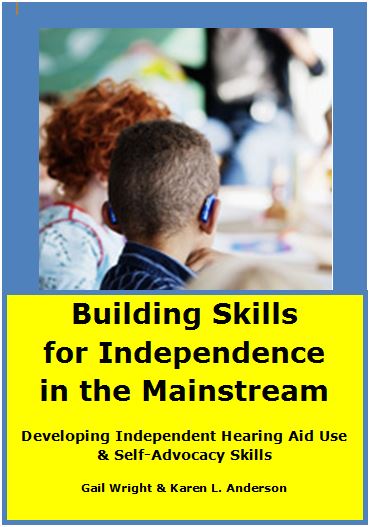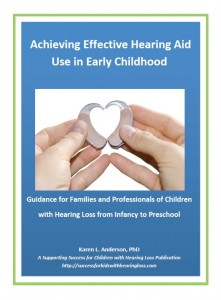Related Products
For Professionals
- Amplification
- Assessment of Student Skills, Challenges, Needs
- Early Childhood: Infants, Toddlers, Preschool
- Hearing Loss – Identification, Impact and Next Steps
- IDEA Law Summary Information
- Language and Speech Development Issues
- Legal Issues in Serving Children with Hearing Loss
- Listening (Auditory Skills) Development
- Planning to Meet Student Needs
- Self-Advocacy Skills for Students with Hearing Loss
- Self-Concept: How the Child with Hearing Loss Sees Himself
- Social Skills
- Speech Perception & Learning
Related Teacher Tools Takeout Items
Expectations for Caring for Hearing Devices
My child wears hearing devices (hearing aids or cochlear implants). What should he be doing to take care of them? How does this change as he gets older? What should I expect?
We expect children to make their beds, set the table or other chores to be a part of the family. They learn to brush their teeth and dress themselves. A child with hearing loss must also learn to take care of their hearing devices. Although the school does have some responsibility for ensuring that the devices are functioning, ultimately learning to become a responsible hearing technology user and communicator with hearing loss is a life long skill that needs to be learned.
the family. They learn to brush their teeth and dress themselves. A child with hearing loss must also learn to take care of their hearing devices. Although the school does have some responsibility for ensuring that the devices are functioning, ultimately learning to become a responsible hearing technology user and communicator with hearing loss is a life long skill that needs to be learned.
 Expectations for developing responsibility over time: SEAM for School Success Student Expectations for Advocacy & Monitoring– The SEAM provides expectations for the level of independence a child should have with their hearing devices. It ranges from staring school (preschool or kindergarten) through high school. The student gradually takes on the responsibility for care and monitoring of hearing devices and also for assertively dealing with challenging listening situations.
Expectations for developing responsibility over time: SEAM for School Success Student Expectations for Advocacy & Monitoring– The SEAM provides expectations for the level of independence a child should have with their hearing devices. It ranges from staring school (preschool or kindergarten) through high school. The student gradually takes on the responsibility for care and monitoring of hearing devices and also for assertively dealing with challenging listening situations.
Help your child care provider understand more about their role in supporting your child. Whether it be a child care center, a neighbor or a family member, share the 4-page handout Welcoming the Child with Hearing Loss into Child Care with them.
The Central Institute for the Deaf offers free resources for those willing to enter their name and email. Download the Ling Sounds Check, Hearing Aid Checklist, Ear Diagram and others.
A video is now available providing instructions for parents, teachers and early interventionists about how to check and monitor hearing aid function. There is also a written handout that can be printed to have available. Watch the Hearing Aid Listening Check video developed by National Center for Hearing Assessment & Management. This 13+ minute video takes awhile to load, but has great information for anyone new to working with hearing aids on little ears!
Important Facts About Hearing Aid Batteries – usage, expected life, needed care.
PERFORMING THE LING SOUND CHECK
The Ling Sound Check is a quick way to make sure that your child is able to hear low, middle and high pitch speech sounds, all of which are necessary if he is to “catch language” as readily as possible. Eventually you will want to be sure he is receiving all the Ling Sounds from close (3 feet) and far (8-10 feet). How well your child hears at a distance will depend on his hearing loss and how well his hearing aids allow him to perceive speech.
What is the Ling Sound Listening Check?
Video: http://www.youtube.com/watch?v=fFnFvWu5mJo
-ah- as in sock -oo- as in you or boo -ee- as in me or eek -sh- as in shhh, baby’s sleeping -s- as in ssssippy cup or snake -m- as in mmmmm, yummy -th- as in thumb (used especially for children who are listening with a cochlear implant) -quiet- this trial is included to see if the child is guessingWhen do I start the Ling Sound Listening Check?
0-6 months
The first step is detection. The Early Listening Function (ELF) checklist provides ways family members can make sounds in the child’s environment, at different distances and then watch for a response. Wait for about 10 seconds and then present a sound and don’t let him see your face as you say the sounds. The ELF listening activities can start about 3 months and children can reliably turn to a sound at about 5-6 months.
Download the ELF from https://teachertoolstakeout.com/0084-teacher-info-assessment
Read the introduction on how to perform the ELF Listening Activities. With the ELF you will not only be observing your baby for responses to sound, you will also be learning the size of his “listening bubble.” Your child will only learn the language presented within the listening bubble. As you will find out, the size of the bubble is smaller in noise and when your baby is not wearing his hearing aids.
6-9 months
- When you place the hearing aid in the baby’s ear, say “Bah, bah, bah, sh, sh, sh – it’s working! Yeah!” Repeat when you put on the other aid. You are modeling a hearing aid self-test that your child will need to learn to do before age 3 or at least before kindergarten.
 At 6-12 months you can say one of the sounds at a normal loudness and watch for the child to turn or otherwise alert to the sound. Say the sound for about 3-5 seconds. Present each sound individually, in random order, over 3 days (example in chart below). Interrupted sounds, like sh sh sh sh are more interesting than just a single presentation – shhhhhh. Present more than one of the Ling Sounds. It isn’t necessary to present them all if he is squirmy and not attentive. Listening time should be fun!
At 6-12 months you can say one of the sounds at a normal loudness and watch for the child to turn or otherwise alert to the sound. Say the sound for about 3-5 seconds. Present each sound individually, in random order, over 3 days (example in chart below). Interrupted sounds, like sh sh sh sh are more interesting than just a single presentation – shhhhhh. Present more than one of the Ling Sounds. It isn’t necessary to present them all if he is squirmy and not attentive. Listening time should be fun!
- Vary the timing between the presentations so it isn’t predictable. Your mouth should be about 8” (about the length of an ink pen) from the baby’s hearing aid microphones. It is best to present the sounds when it is quiet and he is not watching you (sit beside or behind him). If he is too interested in playing with something he may not respond. Once he detects the sound by turning, looking at you, smiling, etc., repeat the sound and then say something like “Great listening! You heard me say /ee/!”
- She should realize that you think she is amazing for responding to the sounds!
- Once she has shown that she can respond to the Ling Sounds at 8 inches, start to increase the distance you are away from her hearing aid microphones. The goal is for children to hear these speech sounds spoken at a typical speaking loudness at a conversational distance with one person (3 feet), two people (6 feet) and even at a distance of 9-10 feet (conversation between more than 2 people and important for catching incidental language).
9-14 months
The second step is imitation.
- This step is in addition to the “say then observe” activities used when the baby is younger. By the end of the 7th month, typically developing babies respond to sounds by imitating with their own and sounds. If your child has very little hearing, even with hearing aids or has not worn hearing aids all waking hours, these early imitation skills are likely to be delayed.
- Once your baby is trying to imitate your speech sounds, start to say the Ling Sounds to him. Smile a lot and include tickles and other ways to make sure this is a fun game. For a video of a baby voicing back when he hears a sound go to: http://www.youtube.com/watch?v=n6HpIstbrug
- Be behind/beside him as you present the sounds to make sure he is using his ears more than his eyes. Each time he responds, point to your ear. When he starts to point to his ear, praise, praise, praise him for hearing the sound!
- His imitations will NOT be exact. Even a child with typical hearing may not clearly the say /s/ sound until he or she is in kindergarten so do not expect your young child to imitate you perfectly! Over time and with practice the child’s sounds will become more similar to yours. Refer to the Speech Skill Production chart for more information about age expectations for speech sound production.
- The important thing is for you to see him respond to sound and to gradually train him to point to his ear as a sign that he heard the sound. Imitating is the icing on the cake! It still does not prove that he understands the sound, even if he can repeat it.
- Make sure you include silent or quiet presentations. Use different distances.
- He will tire quickly of the game so mix up the presentation of the Ling Sounds so during a week they all get presented when the baby is ‘fresh.’
- Pay attention to whether there are any sounds he does not respond or if there are more presentations required before he responds.
- You are the expert on how your baby responds to sound. By practicing the Ling Sound Listening Check at this early age you are gathering very important information about how much the hearing aids are really helping your child perceive speech. Be sure to share the results of your observations with your child’s audiologist and early intervention teacher.
24 months and older
The final level is discrimination.
- With dedicated practice, many children with hearing loss can identify the Ling Sounds by the age of 3, sometimes as early as just after the second birthday.
- Initially, it will be most successful to use real objects or toys to represent each of the Ling Sounds, with pictures of each to use once the child understands the link between the sound and object/picture.For a video showing using real objects go to: http://www.youtube.com/watch?v=Y-mw6e3qDrg or the end of http://leahlefler.hubpages.com/video/How-to-Put-in-a-Childs-Hearing-Aid
- For most children with hearing loss the /s/ and /th/ can be very hard to hear. It isn’t uncommon for the /s/ and /sh/ sounds to be hard for children with hearing aids to tell apart even if they do respond that they hear them. Differences between these sounds may be inaudible or very subtle.
- It is important for you to relate the Ling Sounds to important people or items in the child’s environment. There are three examples that follow including one of how you can take photos in your home and make a series of “Ling Sound Cards” to use with your child. Use only one-syllable words. When you do the Listening Check you will present only the Ling Sound, not the actual word (i.e., say ooo instead of you).
- Young children are overwhelmed if there are too many choices. As you begin to teach the Ling Sound Listening Check to your child, use only two cards at a time. Hold the card next to your face and say the Ling Sound. Do the same with the next card. Repeat. Then put the cards in front of the child and give him a toy to set on top of one or the other (or drop the correct card into a bucket, or any other similar activity). Again, say “Listen” and then produce the Ling Sound.
It will take him awhile to associate the sounds to the cards/pictures. Once he can do the different pairs of two cards then make a set of three. He may be close to three years old before he can do the Ling Sound Listening Check with all 8 cards.
 For a video showing a two year old performing the Listening Check go to: http://speakingofkids.blogspot.com/2012/06/ling-6-sound-test-overview.html
For a video showing a two year old performing the Listening Check go to: http://speakingofkids.blogspot.com/2012/06/ling-6-sound-test-overview.html





